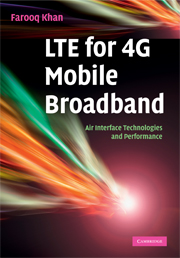Book contents
- Frontmatter
- Contents
- Preface
- 1 Introduction
- 2 Network architecture and protocols
- 3 Downlink access
- 4 Single-carrier FDMA
- 5 Reducing uplink signal peakiness
- 6 Transmit diversity
- 7 MIMO spatial multiplexing
- 8 Channel structure and bandwidths
- 9 Cell search and reference signals
- 10 Random access
- 11 Channel coding
- 12 Scheduling, link adaptation and hybrid ARQ
- 13 Power control
- 14 Uplink control signaling
- 15 Downlink control signaling
- 16 Inter-cell interference control
- 17 Single frequency network broadcast
- 18 Spatial channel model
- 19 LTE performance verification
- Index
12 - Scheduling, link adaptation and hybrid ARQ
Published online by Cambridge University Press: 28 February 2011
- Frontmatter
- Contents
- Preface
- 1 Introduction
- 2 Network architecture and protocols
- 3 Downlink access
- 4 Single-carrier FDMA
- 5 Reducing uplink signal peakiness
- 6 Transmit diversity
- 7 MIMO spatial multiplexing
- 8 Channel structure and bandwidths
- 9 Cell search and reference signals
- 10 Random access
- 11 Channel coding
- 12 Scheduling, link adaptation and hybrid ARQ
- 13 Power control
- 14 Uplink control signaling
- 15 Downlink control signaling
- 16 Inter-cell interference control
- 17 Single frequency network broadcast
- 18 Spatial channel model
- 19 LTE performance verification
- Index
Summary
A cellular radio system consists of a collection of fixed eNBs that define the radio coverage areas or cells. Typically, a non-line-of-sight (NLOS) radio propagation path exists between an eNB and a UE due to natural and man-made objects that are situated between the eNB and the UE. As a consequence, the radio waves propagate via reflections, diffractions and scattering. The arriving waves at the UE in the downlink direction (at the eNB in the uplink direction) experience constructive and destructive additions because of different phases of the individual waves. This is due to the fact that, at the high carrier frequencies typically used in the cellular wireless communication, small changes in the differential propagation delays introduce large changes in the phases of the individual waves. If the UE is moving or there are changes in the scattering environment, then the spatial variations in the amplitude and phase of the composite received signal will manifest themselves as the time variations known as Rayleigh fading or fast fading. Traditionally, the time-varying nature of the wireless channel was considered undesirable because it required very high signal-to-noise ratio (SNR) margins for providing the desired bit error or packet error reliability. Therefore, system design efforts focused on averaging out the signal variations due to fast fading by using various forms of diversity schemes such as space, angle, polarization, field, frequency, time or multi-path diversity.
- Type
- Chapter
- Information
- LTE for 4G Mobile BroadbandAir Interface Technologies and Performance, pp. 291 - 328Publisher: Cambridge University PressPrint publication year: 2009
- 1
- Cited by

